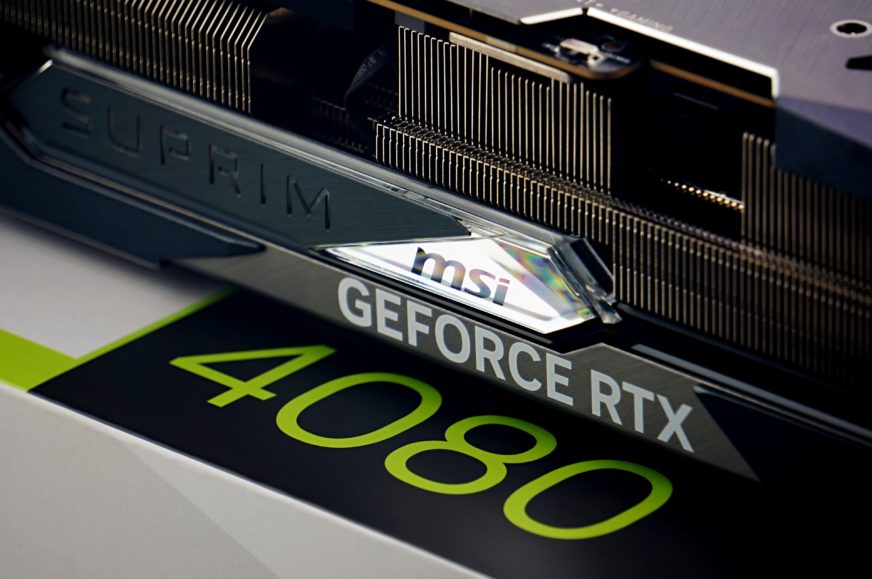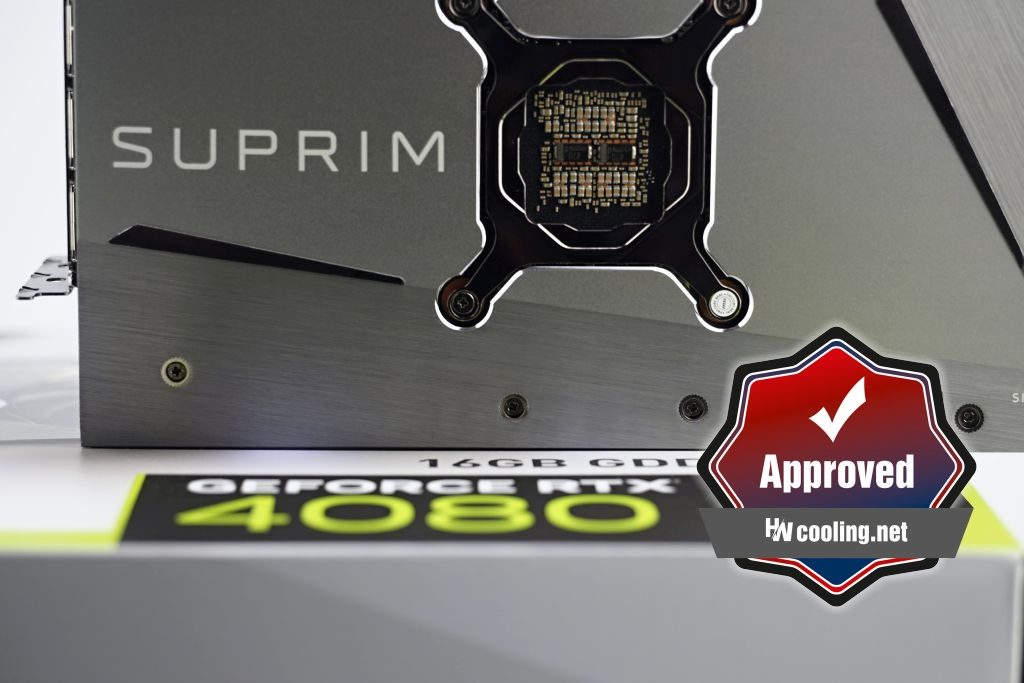Conclusion
From Olympus back to ordinary mortals. Though the GeForce RTX 4080s are quite a bit weaker than the RTX 4090s, they’re also significantly more power-efficient and cheaper. And their performance still exceeds the top models of previous generations of Nvidia and AMD gaming GPUs. In addition, MSI’s most powerful model – the Suprim X – pushes the GPU clock speeds very high, while efficiency is still top-notch.
Conclusion
Unless it’s strictly a graphics card for computing, non-gaming purposes, the RTX 4080 Suprim X makes the most sense at UHD resolution. It has the performance for the vast majority of games in it, and where it is lacking, there is usually DLSS. There will probably be some takers for this card with high-speed QHD monitors, but there’s one thing to note here. With lower resolutions, the RTX 4080’s leap from past generations decreases, this is due to the CPU bottleneck (and this applies even to builds with the most powerful models, including the Intel Core i9-13900K). The question is not “if”, but “to what extent” the processor limits the performance of even a graphics card like the RTX 4080. In UHD (2160p), however, few processors are a bottleneck anymore, as you can see from our tests. At such high resolution, almost the full potential of the card is exploited even with relatively weaker processors, as seen in the power draw, which exceeds the expected 300 W.
The following evaluation of gaming performance will always be from the perspective of 4K, for which this card is best suited. Compared to the Sapphire RX 6900 XT Toxic LE, the RTX 4080 Suprim X’s increase in performance is 26 %. Compared to the lower clock speed RX 6900 XT models, the difference may be even greater, but here we’re comparing two designs that are among the fastest MSI (or in Radeon’s case, Sapphire) has to offer.
To make it as clear as possible, we will create three groups of games. One where the increase of the RTX 4080 Suprim X over RX 6900 XT Toxic LE is under 20 %, under 30 % and over 30 %. There are relatively few titles where the performance increase is the smallest. These are often games that achieve high fps even on weaker cards (Borderlands 3, FIFA 21, Forza Horizon 4 or Total War Saga: Troy). Between 20–30 % upside for the RTX 4080 Suprim X over the RX 6900 XT Toxic LE is in Assassin’s Creed: Valhalla, Control (w/o ray tracing), Cyberpunk 2077 (w/o RT), Red Dead Redemption 2 (w/ Dx12 aj w/ Vulkan API). The largest set of games is with an improvement of over 30 %. This applies to Battlefield V (w/ot RT), as well as DOOM Eternal, F1 2020, Mafia: Definitive Edition, Shadow of the Tomb Raider (w/ot RT), Metro Exodus (w/ot RT) or Wasteland 3. For some titles, it’s specified in brackets that this is a non-ray tracing setting, but we test games with it too. It’s just worth discussing separately.
The performance increase of the RTX 4080 over the RX 6900 XT with ray tracing is often dramatic, in Battlefield V, in Control or in Cyberpunk 2077, it’s up to two and a half-fold, but in the original Metro Exodus and in Shadow of the Tomb Raider it’s “only” +60–75 %, because these games don’t have such complex ray-tracing graphics. Still, with raytracing settings on the RTX 4080, the older GeForce RTX 3080/3090s lose significantly less (than the Radeon RX 69x0s), 35–45 % depending on the game. But in games with more complex RT in 4K, the RTX 4080’s performance is no longer enough for smooth gaming. For example, Cyperpunk 2077 runs pretty uncomfortably (below 30 fps). But with DLLS 2.3 (performance) the fps is already stable above 60. Something similar is the case with Control as well – you need to enable DLSS to run smoothly at maximum detail.
Of the repertoire of games tested, however, there is one where the RTX 4080’s performance is below that of the RX 6900 XT – CS:GO. The GeForce is 24% behind here,But it should be noted that at the same time at significantly lower power draw, by about 40 %.This is due to the fact that the RTX 4080 does not reach its maximum performance here and only goes to 2/3 of its maximum. The RTX 4080 Suprim X is significantly more efficient than older graphics cards in this class. At higher gaming performance, the RTX 4080’s operation is significantly more economical. The Suprim X draw “only” around 300 W (the most we measured is in F1 2020, 307 W), which is still 70–80 W below the Aorus RTX 3080 Xtreme 10G, compared to which the RTX 4080 Suprim X is 30 % more powerful. What is also remarkable compared to previous generations is that the power draw from the PCIe slot (powered by the motherboard’s 24-pin) has been dramatically reduced to only around 7 W.
For those who don’t care about gaming performance, we also have the results of rendering performance tests, for example. It’s 40–45 % faster than the RTX 3080 with the CUDA API in Blender. When rendering video with the Eevee renderer, the performance increase is smaller, 14 %. Compared to the RTX 3090, it is approximately 8 %.
In 3Ds Max, the RTX 4080 has an edge over the RTX 3080 of up to 39 %, the RTX 3090’s disadvantage is smaller (17 %). The Radeon RX 6900 XT lags behind the tested RTX 4080 by about 24 %. The overall size of the video memory also plays a role in these tests. But even where it doesn’t matter that much, which is, for example, the Energy analytics app, the RTX 3090 is down 27 %, the RX 6900 XT then about 25 %. In SolidWorks, the performance of the RTX 4080 is double (compared to the RX 6900 XT). The RTX 4080 Suprim X also has a clear edge over older cards in Autodesk Maya. However, in Autodesk Medical, the RTX 4080 already loses to the RX 6900 XT, and Siemens NX doesn’t suit GeForce graphics cards (including the RTX 4080) at all, there, Radeons are several times faster, even the lower-end models. This app doesn’t squeeze the most out of the GPU in a way that the Adobe Lightroom’s raw, uncompressed photo enhancement tool doesn’t either (Enhanced/RAW details is one of the few filters that uses RTX acceleration), where the RTX 4080 is 3 % faster than the RTX 3080. However, it is important to note here that the graphical load is always very low. Judging by the operating power draw, the RTX 4080 is only loaded to a fifth of its maximum. Similarly, not even at 1/4 throttle, it’s also the case with GPU acceleration filters in Photoshop, where slightly worse results are achieved than with other cards, which one of the new drivers may fix later on.
Information for streamers: Smaller loss of gaming fps performance than with RTX 3080/3090 is due to the concurrent capture by the encoder NVEnc (H.264) both in OBS or in Xsplit.
GPU temperatures are within 60°C, which is low. And even the memory sensor doesn’t report over 66 °C. The fans always run at low speeds. The cooler is thus characterized by a highly efficient design, but that’s why the noisier coils may annoy you all the more. It’s nothing unbearable, but MSI knows better, as they proved with the significantly quieter RTX 3090 Gaming X Trio. RTX 4080 Suprim X coils are 5 dBA noisier. The ratio of the intensity of this sound to the aerodynamic sound of the fans is shown by the spectrographs. The sound of the coils is strongest at around 1050 Hz (but it also extends into very high frequencies, as it is a volatile, wailing sound). That’s the only reason we’re denying this card the “Top-notch” award. As long as this shortcoming doesn’t bother you and you’re comfortable with the price (with a weaker price/performance ratio, which is typical for this class), you won’t find many other reasons to shy away from the RTX 4080 Suprim X. One of the reasons to reach for a discounted RTX 3090 (Ti) might be the smaller size and better compatibility with cases and PCIe expansion cards. And even then, the RTX 3090 (Ti) would have to be priced at least a third lower to make it worthwhile despite that lower efficiency for other reasons (other than the RTX 4080’s poorer compatibility with other components).
And how much beyond specs does the GPU in the RTX 4080 Suprim X work it? Eventually up to 225 MHz. Achieving such high GPU clock speeds (2850 MHz) only applies to lower workloads (CS:GO, Blender, …). With higher loads the clock speeds drop, but not too much. Even at maximum performance they are around 2800 MHz (i.e. 280 MHz above the official boost value of the reference cards).However, an environment with optimum system cooling must be naturally provided for such operation.
TL;DR: The MSI RTX 4080 Suprim X is an efficient graphics card with very high performance suitable for 4K gaming, whose only beauty flaw is the louder coils.
English translation and edit by Jozef Dudáš
| MSI RTX 4080 16GB Suprim X |
| + Top-notch performance (also suitable for 2160p/4K gaming with ray tracing) |
| + Up to 30 % performance increase over RTX 3080 |
| + No competition yet, waiting for AMD equivalent (Radeon RNDA 3) |
| + Very decent performance with ray-tracing |
| + Attractive efficiency – high performance per watt |
| + Efficient Tri Frozr 3S cooler |
| + Exclusive support for DLSS (3), CUDA and OptiX |
| + AV1 encoding support |
| + PCI Express slot bracket/support included |
| + Flashy RGB LED lighting |
| - Weaker price/performance ratio |
| - Noisier coils |
| - Overall larger size and poorer compatibility with cases |
| - DisplayPort only in version 1.4a (applies to all RTX 4080s) |
| Manufacturer's suggested retail price: 1638 EUR |
We are grateful to e-shopu Datacomp for their cooperation in providing the tested hardware
- Contents
- MSI RTX 4080 16GB Suprim X in detail
- Table of parameters
- Methodology: performance tests
- Methodology: how we measure power draw
- Methodology: noise and sound measurement
- Methodology: temperature tests
- Test setup
- 3DMark
- Age of Empires II: DE
- Assassin’s Creed: Valhalla
- Battlefield V
- Battlefield V with DXR
- Borderlands 3
- Control
- Control with DXR and DLSS
- Counter-Strike: GO
- Cyberpunk 2077
- Cyberpunk 2077 with DLSS
- Cyberpunk 2077 with DXR (and DXR with DLSS)
- DOOM Eternal
- F1 2020
- FIFA 21
- Forza Horizon 4
- Mafia: DE
- Metro Exodus
- Metro Exodus with DXR and DLSS
- Microsoft Flight Simulator
- Red Dead Redemption 2 (Vulkan)
- Red Dead Redemption 2 (Dx12)
- Shadow of the Tomb Raider
- Shadow of the Tomb Raider with DXR
- Total War Saga: Troy
- Wasteland 3
- Overall gaming performance and performance per euro
- CompuBench (OpenCL)
- SPECviewperf 2020 and SPECworkstation 3
- FLOPS, IOPS and memory speed tests
- 3D rendering 1/2 (LuxMark and Blender@Cycles)
- 3D rendering 2/2 (Blender@Radeon ProRender and Eevee)
- Photo editing (Adobe Photoshop, Lightroom and Affinity Photo)
- Broadcasting (OBS and Xsplit)
- Password cracking
- GPU clock speeds
- GPU and VRAM temperatures
- Net GPU power draw and performance per watt
- Analysis of 12 V branch power supply (higher load)
- Analysis of 12 V branch power supply (lower load)
- Analysis of 3,3 V branch power supply
- Noise level
- Frequency response of sound
- Conclusion














The cooling is not too great. Lower models like 3070 Gaming Trio do operate silently in comparison. Maybe some blame can be attributed to high TDP. Still disappointing to see. Coil whine with 2 high peaks in the traditional frequency area is even more disappointing. MSI seemed to be the way to go for folks who want to avoid bad coil whine. Not anymore.